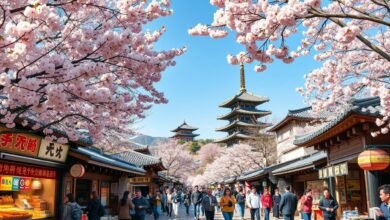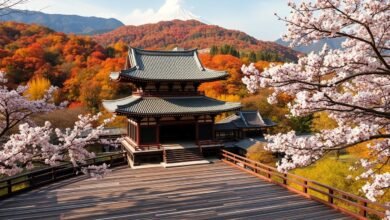
Great Wall & Forbidden City I love travelingt and learning about history. China’s famous landmarks amaze me with their size and beauty. The Great Wall of China is over 5,500 miles long, a true marvel of engineering. The Forbidden City in Beijing is huge, covering more than 100 football fields.
These landmarks are more than just buildings. They show the heart of ancient Chinese culture and the country’s deep history. I’m excited to share what I’ve learned and encourage others to see these incredible places.

Key Takeaways
- The Great Wall of China stretches approximately 5,500 miles, making it one of the world’s most impressive engineering projects.
- The Forbidden City in Beijing covers an astounding 720,000 square meters, equivalent to over 100 football fields.
- These landmarks represent the essence of ancient Chinese architecture and showcase the country’s rich cultural heritage.
- The Great Wall and Forbidden City are both designated as UNESCO World Heritage sites, highlighting their global significance.
- Exploring these iconic landmarks can provide valuable insights into China’s fascinating history and evolution.
Introduction to China’s Historical Heritage
China’s history is a rich tapestry of dynasties, from the Ming Dynasty to the Qing Dynasty. This land is filled with iconic landmarks that show off its architecture, politics, and culture. China welcomes visitors to dive into its Chinese history and learn about its past.
The Great Wall is a symbol of China’s lasting legacy. It stretches over 20,000 kilometers, built to protect against invaders. Today, it’s a marvel of Chinese architecture. Visitors can walk its sections, each with its own story and beauty.
China also has other famous sites, like the Forbidden City. This palace was the center of power for centuries. Its designs and symbols give a peek into China’s past, helping visitors understand its history.
“The Forbidden City is a testament to the architectural and cultural brilliance of ancient China, a true masterpiece that continues to captivate and inspire visitors from around the world.”
China’s history is full of wonders, from palaces to temples and tombs. These sites let visitors explore China’s past. By seeing these places, visitors can learn a lot about Chinese history and its people.
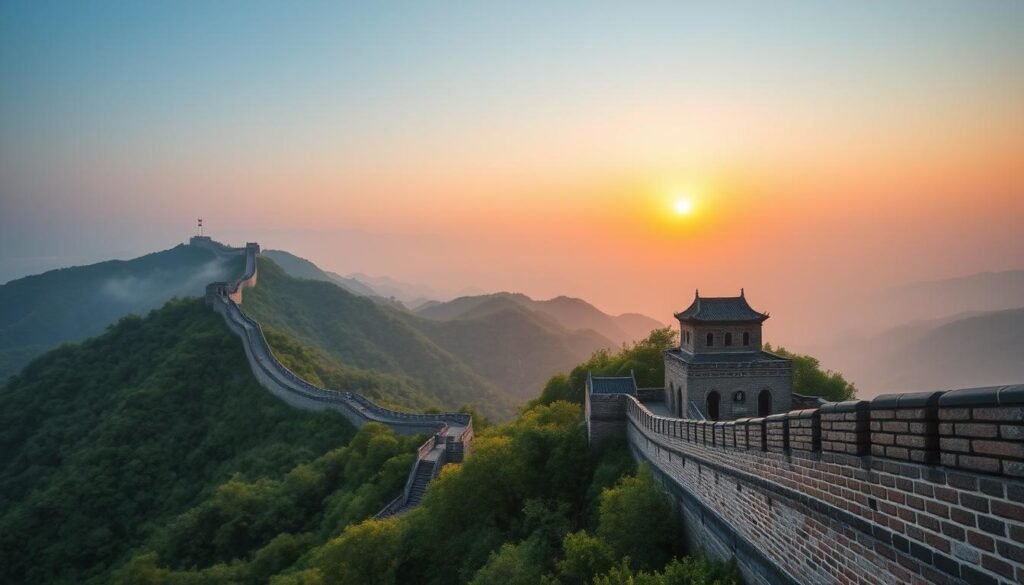
The Great Wall of China: An Architectural Marvel
The Great Wall of china was first built in the Qin Dynasty. It shows China’s deep history and skill in building. The Ming era rebuilt it, showing the Ming Dynasty architecture at its best.
Mutianyu Section: Best-Preserved Ming Dynasty Wall
The Mutianyu section goes back to the Qin Dynasty. It’s less crowded and has cable car access. This ming dynasty architecture gives a peek into the defensive fortifications that protected China’s borders.
Huanghuacheng: Hidden Gems of the Wall
Huanghuacheng is a hidden part of the great wall of china. It was built in the Ming Dynasty. It’s a quiet spot for those wanting to see the wall’s beauty without the crowds.
Badaling: Most Popular Section
The Badaling section is the most visited part of the Great Wall of china. It welcomes millions every year. This section is well-kept and offers great spots for great-wall hiking trails.
The Great Wall of china runs from Shanhaiguan to Lop Nur. It shows many architectural styles and defense strategies. Whether you prefer Huanghuacheng’s quiet or Badaling’s ease, the Wall’s ming dynasty architecture and history are unforgettable.

The Forbidden City: Imperial Palace Complex
The Forbidden City, also known as the Imperial Palace or Palace Museum, is a true gem of Chinese history and culture. It was built in the 15th century. This vast palace complex was home to 24 emperors from the Ming and Qing dynasties. It covers an impressive 72 hectares (720,000 m²) and has over 9,000 rooms.
As one of the top Beijing attractions, the Forbidden City offers a unique look into the lives of Chinese emperors. The palace complex is a prime example of traditional imperial palace. It features magnificent halls, intricate courtyards, and a treasure trove of rare artifacts. Exploring the Forbidden City Palace is like stepping back in time, where you can imagine the pomp and ceremony that once filled these historic walls.
The Forbidden City is not just a static museum, but a living testament to China’s rich cultural heritage. The Forbidden City museums within the palace complex house an extensive collection of artifacts and artwork. This provides visitors with a deeper understanding of the country’s imperial past. From exquisite porcelain to ancient calligraphy, each item tells a story of the dynasties that once reigned over this extraordinary place.
“The Forbidden City is not just a palace, but a treasure trove of Chinese history and culture.”
With its impressive scale, intricate architecture, and unparalleled cultural significance, the Forbidden City stands as one of the most iconic beijing attractions in China. Whether you’re a history buff or simply in awe of the country’s remarkable past, a visit to this extraordinary palace complex is a must-do for any traveler to China.

From the Great Wall to the Forbidden City: Top Historical Landmarks in China
China’s rich history is seen in its famous landmarks. Each one shows a part of China’s past. The Great Wall and the Forbidden City are just a few examples, lasting for centuries.
Historical Significance Through Dynasties
The Great Wall of China is over 13,000 miles long. It shows the skill of the Qin, Han, and Ming dynasties. The Forbidden City in Beijing has more than 9,000 rooms and was home to 24 emperors.
These landmarks show China’s history through dynasties. They show the ambition, creativity, and culture of each time.
Cultural Impact on Modern China
These sites have greatly shaped China’s identity. The Temple of Heaven is a UNESCO site, showing China’s architecture and traditions. The Summer Palace’s gardens and pavilions inspire artists today.
Preservation Efforts
China works hard to keep these landmarks safe. The Ming Tombs and the Lama Temple have been restored. UNESCO helps protect China’s heritage for the future.
China’s landmarks remind us of its rich history. They show how China’s past shapes its present. By visiting these sites, we learn about China’s culture and its people’s dreams.
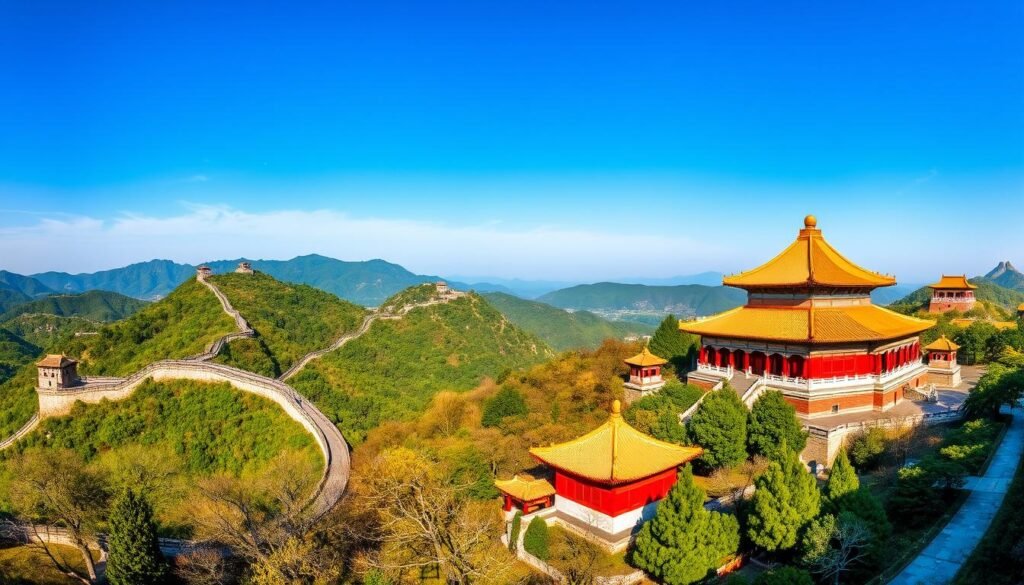
The Terracotta Army: Warriors of the First Emperor
In 1974, the Terracotta Army was discovered, revealing the splendor of China’s Qin dynasty. Found by farmers near Xi’an, it includes over 8,000 terracotta warriors, horses, and chariots. These were part of the mausoleum for Qin Shi Huang, China’s first emperor.
The terracotta army is breathtaking in scale and detail. Each warrior has its own face, clothes, and look. This shows the skill of ancient craftsmen. It’s believed that over 720,000 workers built this massive tomb, showing the Qin dynasty’s power and dreams.
Archaeologists have found three main pits at the site. Pit 1 has over 3,000 figures, showing the main army. Pit 2 has cavalry and chariots, and Pit 3 has a high command chariot. These finds give us a deep look into the Qin’s military and the vision of its first emperor.
Now, the Terracotta Army is a top historical site in China, attracting millions. It’s on the UNESCO World Heritage list, showing its importance worldwide. It’s a key place for anyone wanting to see China’s cultural treasures.
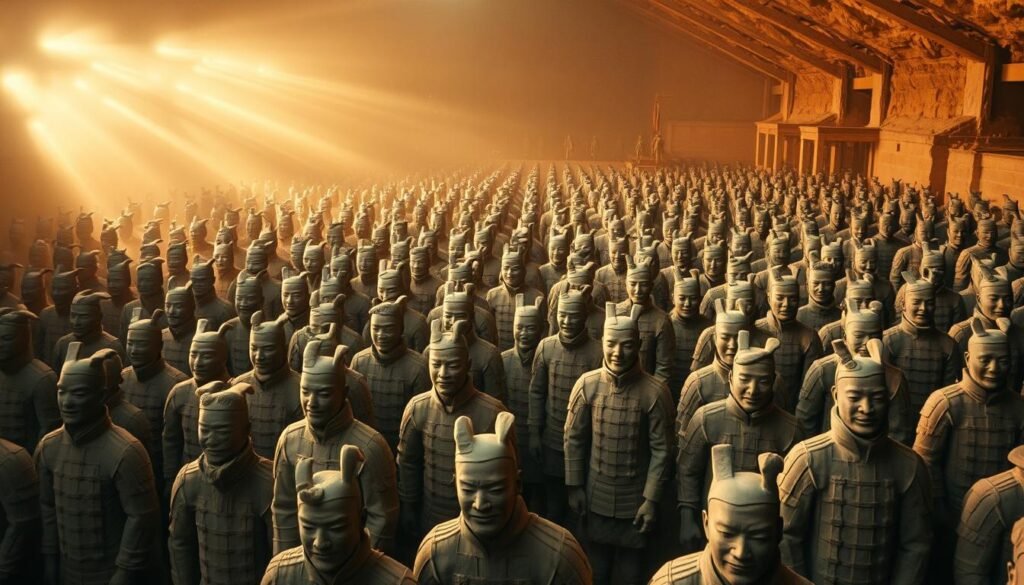
“The Terracotta Army is a stunning testament to the ambition and ingenuity of the Qin dynasty. Its discovery has revolutionized our understanding of ancient Chinese history and culture.”
Temple of Heaven: Sacred Imperial Complex
In the heart of Beijing, the Temple of Heaven is a symbol of China’s rich culture. Built from 1406 to 1420, it was a place for emperors to pray for good harvests and heaven’s favor.
Architectural Symbolism
The Temple of Heaven combines Chinese architecture and religion beautifully. Its buildings are square for the earth and round for the sky. The Hall of Prayer for Good Harvests is huge, showing the grandeur of imperial rituals.
Religious Significance
The Temple of Heaven was very important for Chinese emperors. They would hold the Tianxin ceremony here, praying for a good year and harvest. This showed they were the link between heaven and earth, proving their right to rule.
Cultural Ceremonies
- The Temple of Heaven hosted grand ceremonies, like the Qinian sacrificial ceremony, where the emperor would offer sacrifices to the heavens.
- During the Chongyang festival, the emperor would lead a big procession to the temple. They would perform rituals and make offerings, seeking the gods’ blessings.
- The Altar of Heaven, a circular platform, was the center of these ceremonies. Here, the emperor would talk to the divine.
Today, the Temple of Heaven is a symbol of China’s cultural legacy. It’s a sacred place where the emperors’ connection to heaven was celebrated. As a UNESCO World Heritage site, it attracts visitors worldwide, showing the traditions and beliefs of Chinese civilization.
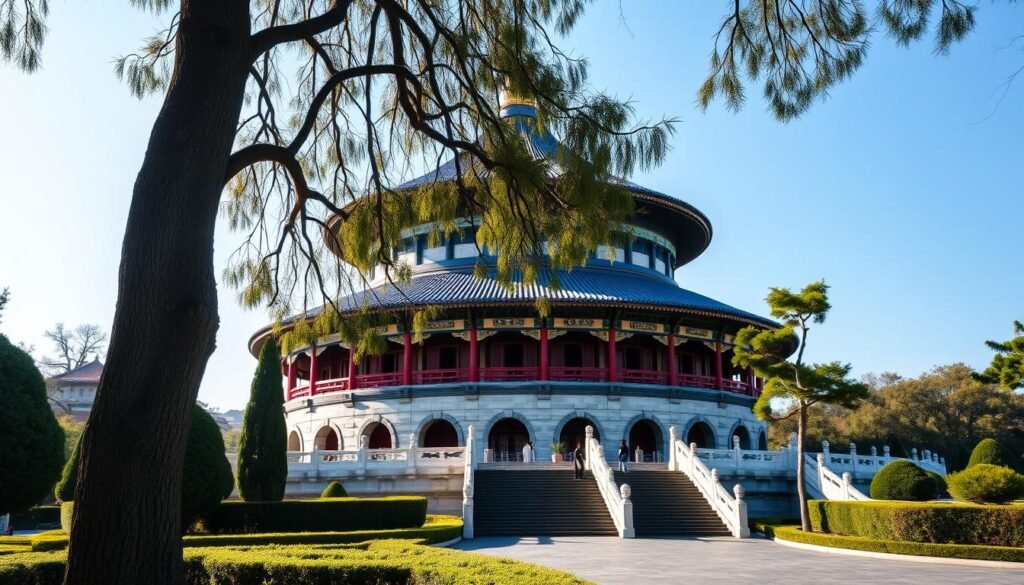
| Fact | Statistic |
|---|---|
| Construction Period | 1406 – 1420 (Ming Dynasty) |
| Complex Size | 2.73 km2 (1.05 sq mi) |
| Hall of Prayer for Good Harvests | 36 m (118 ft) in diameter, 38 m (125 ft) tall |
| UNESCO World Heritage Site | Inscribed in 1998 |
| Park Size | 267 hectares (660 acres) |
| Visitor Access | Open daily from 6:00 am to 10:00 pm |
Summer Palace: Royal Garden Heritage
As I walk through the Summer Palace in Beijing, I feel like I’ve stepped back in time. This vast palace, covering 2.9 square kilometers, shows China’s rich history and culture. It’s a true marvel of architecture and heritage.
The palace was first built in 1750 and then revamped in 1886. It beautifully combines nature and man-made wonders. At its heart is Kunming Lake, a 2.2 square kilometer gem, and Longevity Hill, offering a peaceful escape from the city’s noise.
The Long Corridor is a highlight, with its 728-meter length and detailed paintings. The Marble Boat and the Tower of Buddhist Incense add to the palace’s charm. They remind us of the grandeur of ancient China.
| Key Facts about the Summer Palace | Figures |
|---|---|
| Total Area | 297 hectares (with a 5,545-hectare buffer zone) |
| Kunming Lake Area | 2.2 square kilometers |
| Number of Ancient Buildings | Over 3,000 |
| Historical Relic Collection | Over 40,000 |
| Original Construction Cost | 4.8 million silver taels |
| Reconstruction Cost (1884-1895) | 22 million silver taels |
The Summer Palace is more than just a historical site. It has inspired garden design across the world. As a UNESCO World Heritage Site, it shows China’s dedication to preserving its cultural treasures for the future.
“The Summer Palace in Beijing is a masterpiece of Chinese landscape garden design. It perfectly blends natural landscapes with exquisite architectural features, creating a harmonious and visually stunning environment.”
A visit to the Summer Palace is a must for anyone interested in ancient Chinese architecture and heritage. Whether you’re drawn to its history, beauty, or cultural importance, it’s an unforgettable experience.
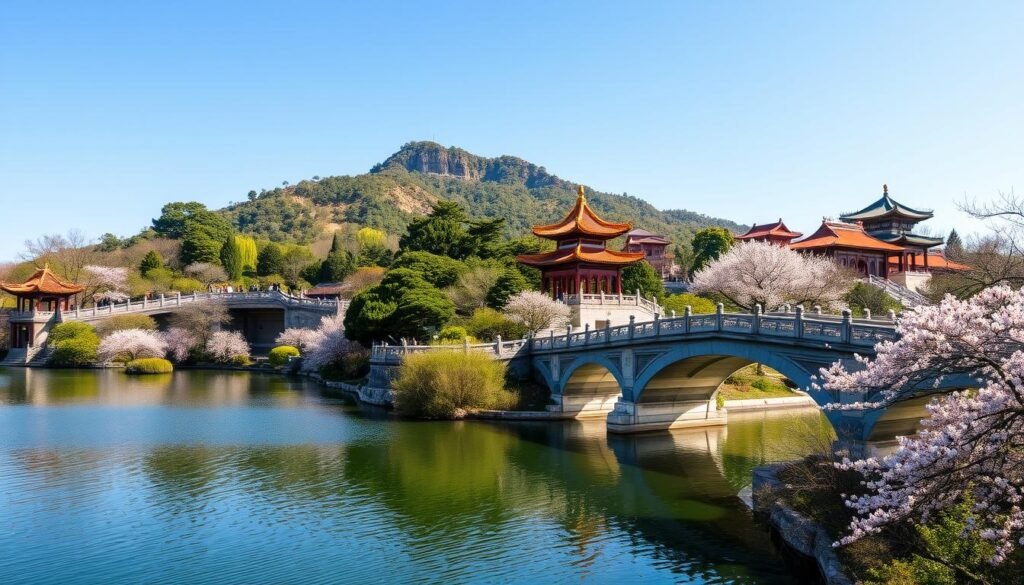
Ming Tombs: Imperial Burial Grounds
The Ming Tombs are a peaceful spot, just 50 kilometers northwest of Beijing. They showcase China’s rich Ming Dynasty history. This vast area holds the tombs of 13 Ming Dynasty emperors, highlighting the era’s grandeur and cultural importance.
Chang Ling Tomb: Ornate Elegance
The Chang Ling is a standout among the Ming Tombs. It’s where Emperor Yongle, the third ruler of the Ming Dynasty, rests. Built in the 15th century, it’s famous for its stunning interiors and architecture. It gives a peek into the lavish world of imperial China.
Ding Ling Underground Palace: Buried Treasures
The Ding Ling is another key tomb in the complex. It’s where Emperor Wanli, the 13th emperor of the Ming Dynasty, is buried. What makes Ding Ling special is that it’s the only underground palace that’s been excavated and opened to visitors. It offers a unique chance to see the tombs and discover their hidden treasures.
The Ming Tombs complex is a true marvel of the Ming Dynasty. Its beautiful architecture, detailed designs, and vast history make it a must-see. It’s a place where you can dive deep into China’s imperial past.
Ancient Chinese Architecture and Design Principles
The ancient Chinese architecture shows the creativity and ingenuity of the Chinese people. It ranges from grand imperial palaces to peaceful classical gardens. These architectural wonders have amazed the world for centuries.
At the core of this legacy are deep design principles. These principles have shaped China’s built environment for thousands of years.
Timber-frame structures are a key feature of ancient Chinese architecture. Wooden posts, beams, and lintels make up the buildings. This method creates large, open spaces and makes structures last long.
The concept of “feng shui” greatly influenced these structures. It aims to harmonize the built environment with nature. This ensures a balance between beauty and function.
Symmetry and hierarchy are also key in ancient Chinese architecture. Imperial palaces, like the Forbidden City, follow strict symmetrical layouts. This shows power and order, reflecting the harmony between heaven and earth.
Unique architectural elements add to the beauty of ancient Chinese buildings. Upturned eaves, intricate joineries, and yellow roof tiles are examples. These features serve practical and symbolic purposes.
The influence of ancient Chinese architecture is seen in famous landmarks like the Great Wall and Suzhou gardens. These continue to inspire and show the lasting impact of Chinese design principles.
“The beauty of traditional Chinese architecture lies in its harmonious integration of function and form, where every element serves a practical purpose while also embodying the essence of the country’s rich cultural heritage.”
UNESCO World Heritage Status and Preservation
China’s historical landmarks have gained global fame, earning UNESCO World Heritage status. This honor boosts conservation and draws tourists. Sites like the Great Wall and Forbidden City show China’s architectural genius and lasting impact.
Conservation Challenges
Keeping these sites safe is tough. Weather and natural disasters are big threats. Also, too many tourists and urban growth can harm them. The Chinese government and UNESCO work hard to protect these treasures for the future.
International Recognition
- China has the second-highest number of UNESCO World Heritage Sites in the world, with a total of 59 sites.
- The Great Wall, Forbidden City, and Terracotta Army are among the most renowned World Heritage Sites in China, reflecting the country’s rich history and architectural prowess.
- Other notable UNESCO-listed sites include the Mukden Palace, Mogao Caves, Mount Tai, Huanglong and Jiuzhaigou Valleys, and the Historic Ensemble of the Potala Palace.
- As of 2019, China boasts a total of 55 UNESCO World Heritage Sites, tying it with Italy for the top spot globally.
This recognition boosts China’s efforts to preserve its culture. It also helps the world appreciate China’s rich heritage.
Tourism Impact and Visitor Guidelines
China’s historical landmarks, like the Great Wall and the Forbidden City, attract many tourists. These sites bring in a lot of money for local economies. The Forbidden City, for example, welcomes over 14 million visitors each year.
To keep these sites safe, there are rules for visitors. These include not touching artifacts and following photography rules. Guided tours and educational programs help visitors learn and enjoy their time.
There are efforts to make tourism better for the environment and culture. Visitors are asked to respect local customs and follow guidelines. This helps protect these treasures for the future.
Visiting the Forbidden City
The Forbidden City is a UNESCO World Heritage site. It has over 1 million valuable objects. To keep it safe, there are strict rules for visitors.
- Ticket Prices: Peak season tickets cost 60 CNY (approximately $8.50 USD), while off-peak season tickets are priced at 40 CNY (approximately $5.70 USD).
- Average Visit Duration: Visitors typically spend about half a day exploring the Forbidden City’s expansive grounds and historic buildings.
- Best Times to Visit: Off-peak season from November to March, as well as weekdays and early mornings/late afternoons, tend to have fewer crowds.
- Recommended Route: Meridian Gate, Gate of Supreme Harmony, Hall of Supreme Harmony, Hall of Central Harmony, Hall of Preserving Harmony, and the Imperial Garden.
By following the rules and immersing themselves in the culture, visitors help preserve China’s heritage. This way, they ensure these landmarks are enjoyed by future generations.
“The Forbidden City is not just a historical site, but a living testament to China’s enduring cultural legacy. Exploring its grand architecture and hidden treasures is a truly immersive experience.” – Lonely Planet
Cultural Significance in Modern China
China’s historical landmarks are key to its identity and education. They connect the country to its rich past, boosting national pride and cultural ties. These sites are now part of school lessons, teaching young people about history and culture.
Students in China learn about the country’s architectural wonders, tech leaps, and artistic feats. Places like the Forbidden City in Beijing and the Terracotta Army in Xi’an are more than just sites. They are living classrooms that deepen understanding of Chinese history and culture.
China’s landmarks also shape its modern art, literature, and pop culture. They symbolize the country’s tech and cultural strength, drawing global interest in cultural tourism china. This makes them crucial in building national identity and boosting Chinese pride.
“These landmarks are not just relics of the past, but living testaments to China’s enduring spirit and innovation. They serve as a bridge between our rich heritage and our dynamic present.”
As China grows, its historical landmarks stay strong, keeping the nation’s spirit alive. They inspire future generations to cherish their cultural heritage.
Best Times to Visit Historical Sites
Exploring China’s rich historical landmarks is a must for any cultural enthusiast. But when is the best time to visit these iconic sites? As a seasoned traveler, I’ve found that spring and autumn are the ideal seasons.
The spring months of April and May have mild temperatures and clear skies. You can see beautiful flowers in many gardens and palaces. This is a great time to visit the Great Wall of China and the Forbidden City in Beijing. The weather is comfortable, and there are fewer crowds than in the summer.
The September to October autumn period is another excellent choice. It offers crisp air, vibrant foliage, and fewer tourists. This is the best time to see the Terracotta Army in Xi’an and the Temple of Heaven in Beijing. The climate is pleasant, and the sites are less crowded.
| Site | Best Time to Visit | Highlights |
|---|---|---|
| Great Wall of China | September to November | Less rain, more clear days |
| Forbidden City | Early mornings | Fewer crowds |
| Terracotta Army | Year-round | Climate-controlled environment |
| Temple of Heaven | September to October | Comfortable weather, fewer tourists |
The summer months of June to August are hot and crowded. But they offer unique chances, like cultural festivals and vibrant nightlife in cities like Beijing. Families with schoolchildren might find June a good time due to reasonable prices and weather.
The winter months of December to February have a different charm. You can see the historical sites covered in snow, especially at the Great Wall. But it’s cold, so remember to pack warm clothes.
It’s wise to check for any restoration work or special events before visiting these historical treasures. With some planning and flexibility, you can have an unforgettable cultural exploration of China’s most iconic landmarks.
Conclusion
Exploring China’s historical landmarks has been a journey full of wonder. It has given us a deep look into one of the world’s oldest and most influential civilizations. The Great Wall and the Forbidden City show China’s amazing architecture and deep culture.
These sites are more than just buildings. They tell the story of China’s past and help shape its identity today. They show how China’s culture is seen around the world.
Many of these landmarks are UNESCO World Heritage sites. This means they get help from all over to keep them safe for the future. Visiting these places gives us a special view of China’s role in world history.
Seeing the Great Wall, the Forbidden City, and the Temple of Heaven is unforgettable. It’s like stepping back in time. These experiences show us the heart of ancient Chinese civilization.
Thinking back on my time in China, I really appreciate its lasting legacy. The history, architecture, and people of China are all part of these landmarks. By seeing these sites, I’ve learned to value ancient Chinese design even more.
These cultural sites are a true reflection of the Chinese spirit. They are a must-see for anyone wanting to dive into China’s rich history and culture. It’s a journey that changes you forever.
FAQ
What are some of the top historical landmarks in China?
China’s top landmarks include the Great Wall, the Forbidden City, and the Terracotta Army. Also, the Temple of Heaven, Summer Palace, and Ming Tombs are notable. These sites show China’s rich culture and ancient architecture.
What is the significance of the Great Wall of China?
The Great Wall of China is a UNESCO World Heritage site. It stretches about 5,500 miles. Built mainly during the Ming Dynasty, it offers a glimpse into ancient China’s defense and architecture.
What makes the Forbidden City in Beijing so significant?
The Forbidden City was built in the 15th century. It was home to 24 emperors. With over 70 palaces and 9,000 rooms, it showcases Chinese architecture and houses rare artifacts.
What is the significance of the Terracotta Army in Xi’an?
The Terracotta Army dates back to the 3rd century BC. It was part of Emperor Qin Shi Huang’s mausoleum. Discovered in 1974, it includes around 7,000 clay soldiers, horses, and chariots, each unique.
How have China’s historical landmarks been preserved and recognized?
Landmarks like the Great Wall, Forbidden City, and Terracotta Army have UNESCO World Heritage status. This has helped with conservation and tourism. The Chinese government and UNESCO work together to protect these sites.
What is the cultural significance of China’s historical landmarks in modern times?
China’s landmarks are key to its modern identity and education. They connect the country to its past, fostering pride and cultural continuity. These sites are part of school curricula and influence art, literature, and popular culture.
When is the best time to visit China’s historical landmarks?
Spring (April-May) and autumn (September-October) are the best times to visit. The weather is mild, and there are fewer crowds. Summer is hot and crowded, while winter is cold but offers unique views. Check for restoration works or special events before visiting.



